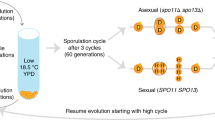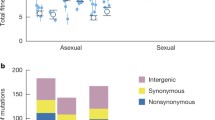Abstract
This article develops a simplified set of models describing asexual and sexual replication in unicellular diploid organisms. The models assume organisms whose genomes consist of two chromosomes, where each chromosome is assumed to be functional if it is equal to some master sequence σ0, and non-functional otherwise. We review the previously studied case of selective mating, where it is assumed that only haploids with functional chromosomes can fuse, and also consider the case of random haploid fusion. When the cost for sex is small, as measured by the ratio of the characteristic haploid fusion time to the characteristic growth time, we find that sexual replication with random haploid fusion leads to a greater mean fitness for the population than a purely asexual strategy. However, independently of the cost for sex, we find that sexual replication with a selective mating strategy leads to a higher mean fitness than the random mating strategy. The results of this article are consistent with previous studies suggesting that sex is favored at intermediate mutation rates, for slowly replicating organisms, and at high population densities. Furthermore, the results of this article provide a basis for understanding sex as a stress response in unicellular organisms such as Saccharomyces cerevisiae (Baker’s yeast).





Similar content being viewed by others
References
Agrawal AF, Chasnov JR (2001) Recessive mutations and the maintenance of sex in structured populations. Genetics 158:913
Alves D, Fontanari JF (1997) Error threshold in the evolution of diploid organisms. J Phys A 30:2601
Andersson M (1994) Sexual selection. Princeton University Press, Princeton
Barton NH, Charlesworth B (1998) Why sex and recombination. Science 281:1986
Bell G (1982) The masterpiece of nature: the evolution and genetics of sexuality. Croom Helm, London
Bernstein H, Byerly HC, Hopf FA, Michod RE (1985) Genetic damage, mutation, and the evolution of sex. Science 229:1277
Cebrat S, Stauffer D (2008) Gamete recognition and complementary haplotypes in sexual Penna aging model. Int J Modern Phys C 19:259–265
Chasnov JR (2000) Mutation-selection balance, dominance and the maintenance of sex. Genetics 156:1419
De Massy B, Baudat F, Nicolas A (1994) Initiation of recombination in Saccharomyces cerevisiae haploid meiosis. Proc Natl Acad Sci USA 91:11929–11933
Dolgin ES, Otto SP (2003) Segregation and the evolution of sex under overdominant selection. Genetics 164:1119
Haag CR, Roze D (2007) Genetic load in sexual and asexual diploids: segregation, dominance and genetic drift. Genetics 176:1663
Hamilton WD, Axelrod R, Tanese R (1990) Sexual reproduction as an adaptation to resist parasites (a review). Proc Natl Acad Sci USA 87:3566
Herskowitz I (1988) Life cycle of the budding yeast Saccharomyces cerevisiae. Microbiol Rev 52:536–553
Hurst LD, Peck JR (1996) Recent advances in understanding of the evolution and maintenance of sex. Trends Evol Ecol 11:46
Lee B, Tannenbaum E (2007) Asexual and sexual replication in sporulating organisms. Phys Rev E 76:021909
Mable BK, Otto SP (1998) The evolution of life cycles with haploid and diploid phases. BioEssays 20:453–462
Maynard-Smith J (1978) The evolution of sex. Cambridge University Press, Cambridge
Michod RE (1995) Eros and evolution: a natural philosophy of sex. Addison-Wesley, New York
Muller HJ (1964) The relation of recombination to mutational advance. Mutat Res 1:2
Otto SP (2003) The advantages of segregation and the evolution of sex. Genetics 164:1099
Otto SP, Lenormand T (2002) Resolving the paradox of sex and recombination. Nat Rev Genet 3:252–261
Pilar Garcillan-Barcia M, de la Cruz F (2008) Why is entry exclusion an essential feature of conjugative plasmids? Plasmid 60:1–18
Roeder GS (1995) Sex and the single cell: meiosis in yeast. Proc Natl Acad Sci USA 92:10450–10456
Tannenbaum E (2006) Selective advantage for sexual reproduction. Phys Rev E 73:061925
Tannenbaum E (2008a) Comparison of three replication strategies in complex multicellular organisms: asexual replication, sexual replication with identical gametes, and sexual replication with distinct sperm and egg gametes. Phys Rev E 77:011915
Tannenbaum E (2008b) A comparison of asexual and sexual replication strategies in a simplified model based on the yeast life cycle. Theory Biosci. doi:10.1007/12064-008-0049-5
Tannenbaum E, Fontanari JF (2008) A quasispecies approach to the evolution of sexual replication in unicellular organisms. Theory Biosci 127:53
Williams GC (1975) Sex and evolution. Princeton University Press, Princeton
Acknowledgments
This research was supported by a Start-Up Grant from the United States—Israel Binational Science Foundation, and by an Alon Fellowship from the Israel Science Foundation. The author would also like to thank J. F. Fontanari for helpful conversations leading to the completion of this work.
Author information
Authors and Affiliations
Corresponding author
Appendices
Appendix 1: Derivation of the steady-state mean fitness for the selective mating strategy
For the selective mating strategy, the steady-state equations are given by,
where \( \bar{\kappa}(t = \infty) = -\kappa_{\rm vv} x_{\rm vv} - \kappa_{\rm vu} x_{\rm vu} + \gamma \rho^{*} x_{\rm v}^2 .\) We purposely neglect the steady-state equation corresponding to d x uu/dt = 0, since this equation will not be necessary to determine the mean fitness of the population.
Solving the last equation for γρ* x 2v and substituting the result into the expression for \( \bar{\kappa}(t = \infty) \) gives,
and so,
We also have,
Substituting these values into the expression for \( \bar{\kappa}(t = \infty) ,\) and making use of the fact that ρ* = ρ/(1 + (1/2) (x v + x u)) gives, after some manipulation,
The steady-state equations for x vv and x vu then give,
Therefore, x vu/x vv = B vv/A vv × (1 + ϕss)/(α + ϕss), so that
Now, the first steady-state equation for x vv may be solved to give, x vv + αx vu + ϕss = (1 + ϕss) x vv/A vv, which may be substituted into Eq. A5 to give,
Substituting in the value for x vv gives, after some manipulation, Eq. 6 defining the steady-state mean fitness.
Appendix 2: Derivation of the steady-state mean fitness for the random mating strategy
For the random mating strategy, the steady-state equations are,
where \( \bar{\kappa}(t = \infty) = -\kappa_{\rm vv} x_{\rm vv} - \kappa_{\rm vu} x_{\rm vu} + \gamma \rho^{*} (x_{\rm v} + x_{\rm u})^2 .\) The third equation is obtained by adding the equations corresponding to d x v/dt = d x u/dt = 0.
We then have,
so that,
If we define \( \tilde{x}_{\rm v} = x_{\rm v}/(x_{\rm v} + x_{\rm u}) ,\; \tilde{x}_{\rm u} = x_{\rm u}/(x_{\rm v} + x_{\rm u}) ,\) then,
and so,
By substituting the expression for x v + x u into the expression defining \( \bar{\kappa}(t = \infty) ,\) we obtain, after some manipulation,
The steady-state equations for x vv and x vu give,
Now, from Eq. B2 it can be seen that ϕrs ≤ x vv + α x vu, and so from Eq. B6 we have,
where λ ≡ κvv/(2γρ), \( f(\phi_{\rm rs}, \lambda) \equiv (1 + \sqrt{\lambda \phi_{\rm rs}})/(1 - \sqrt{\lambda \phi_{\rm rs}}) .\)
We now have,
The second equation gives,
Now, ϕ 2rs f(ϕrs, λ)2 − x 2vv = −(ϕrs f(ϕrs, λ) + x vv)2 + 2ϕ 2rs f(ϕrs, λ)2 + 2ϕrs f(ϕrs, λ) x vv, and so, after some manipulation, we obtain,
where we made use of the fact that B vv − B vu = −2A vv and 2(1 + ϕrs) x vv = (1 + f(ϕrs, λ))/(2ϕrs f(ϕrs, λ)2) A vv (ϕrs f(ϕrs, λ) + x vv)2.
Plugging the value of x vv back into the first equation from Eq. B9 we obtain, after tedious algebra,
Now, \( 1 + f(\phi_{\rm rs}, \lambda) = 2/(1 - \sqrt{\lambda \phi_{\rm rs}}) ,\) and so, multiplying both sides by \( (1 - \sqrt{\lambda \phi_{\rm rs}})^2 \) gives Eq. (7) defining the steady-state mean fitness.
Rights and permissions
About this article
Cite this article
Tannenbaum, E. Selective advantage for sexual reproduction with random haploid fusion. Theory Biosci. 128, 85–96 (2009). https://doi.org/10.1007/s12064-008-0054-8
Received:
Accepted:
Published:
Issue Date:
DOI: https://doi.org/10.1007/s12064-008-0054-8




